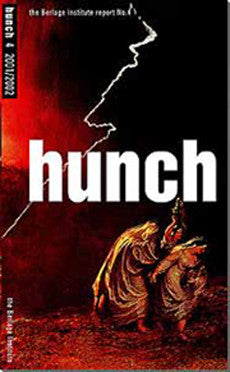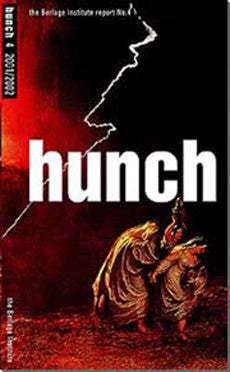Your cart is currently empty!
HUNCH 4
+++ +++
+++Jennifer Sigler [ed.]+++
Mick Morssink
192
30 x 16.5
Paperback
special offer: now only € 7.50 instead of € 15,00 [the Netherlands] € 17,50 [Europe] € 19,50 [outside Europa]
'Architecture isn't the most important thing,' says Oscar Niemeyer; 'What's important is life....' But it was the other way around for the Dutch %22outsider%22 architect Gert Jan Willemse: 'Willemse didn't make architecture to live in, but for life,' says his professor Geert Bekaert in this issue. Willemse ended his own life, after careful preparations, at the age of 30. 'For him it was finished.' And his 'autonomous architecture,' constructed of tiny pencil dots on paper, was more final than it could ever have been as 'built' in this world.
'Idedicate my work to Allah,' wrote Mohammed Atta, a graduate student in urban design at the Technical University of Hamburg, at the beginning of his thesis, entitled 'The Conflict between Islam and Modernization in Aleppo, Syria.' After leaving school, he too carried out a carefully planned suicide when he took over the cockpit of a 747 and aimed it toward one of New York's twin towers. Again, life was less important than a higher cause. And like Willemse's tiny gray dots, the World Trade Center was ultimately immaterial: 'Just dust.' And in the form of dust, architecture became final.
If, as Thomas A. P. van Leeuwen writes in 'Columns of Fire,' 'creation and destruction are a symmetrical unit...' and if fire 'heralds a new and fresh beginning,' then the destruction of the WTC , in biblical terms, might have been predicted. But whichever contemporary names and faces we insert into John Martin's painting The Destruction of Sodom and Gomorrah on the cover, whichever people are fleeing their burni
On September 11th, HUNCH 4 was well underway, focusing not on the either/or extremes of architecture and life, but on this 'mess' of reality - the complex negotiations between the profession of architecture/urbanism and the changing world. Confronting and understanding the mess is the aim of the Stealth Group, four architects who work like scientists in the laboratory of Belgrade. The beauty of this 'Wild City' is that its uncontrolled growth yields its own solutions. Stealth asks: can Belgrade's successful systems of 'self-organization' be consciously applied? As the name, Stealth, suggests, there is a sneaky quality to these kinds of interventions; they bypass whatever 'official' channels for change exist - if they exist at all - and very gradually, almost imperceptibly, identify new ones. Stealth exerts a certain resistance from within the mess; they are the city's rebel-angels.
To venture into the mess, rather than to seek an 'autonomy' of architecture, is of course what Rem Koolhaas has been doing all along, in his research from Delirious New York to Pearl River Delta to Lagos, Nigeria. But to build - to physically confront, or even take part in the mess - is a different task. The two new Guggenheim Museums, implanted in the Venetian Hotel in Las Vegas, are OMA's dialogues with what Koolhaas calls 'Junkspace,' where the borders between 'junk' and 'Architecture' are both exaggerated and diffused.
If, in Las Vegas, culture (The Guggenheims) have been 'folded into' commerce (the Venetian Hotel and Casino), and c
€7.50
HUNCH 4
€7.50
Architecture / Bookazines / Series / Theory / Urbanism
Mick Morssink
192
30 x 16.5
Paperback
special offer: now only € 7.50 instead of € 15,00 [the Netherlands] € 17,50 [Europe] € 19,50 [outside Europa]
'Architecture isn't the most important thing,' says Oscar Niemeyer; 'What's important is life....' But it was the other way around for the Dutch %22outsider%22 architect Gert Jan Willemse: 'Willemse didn't make architecture to live in, but for life,' says his professor Geert Bekaert in this issue. Willemse ended his own life, after careful preparations, at the age of 30. 'For him it was finished.' And his 'autonomous architecture,' constructed of tiny pencil dots on paper, was more final than it could ever have been as 'built' in this world.
'Idedicate my work to Allah,' wrote Mohammed Atta, a graduate student in urban design at the Technical University of Hamburg, at the beginning of his thesis, entitled 'The Conflict between Islam and Modernization in Aleppo, Syria.' After leaving school, he too carried out a carefully planned suicide when he took over the cockpit of a 747 and aimed it toward one of New York's twin towers. Again, life was less important than a higher cause. And like Willemse's tiny gray dots, the World Trade Center was ultimately immaterial: 'Just dust.' And in the form of dust, architecture became final.
If, as Thomas A. P. van Leeuwen writes in 'Columns of Fire,' 'creation and destruction are a symmetrical unit...' and if fire 'heralds a new and fresh beginning,' then the destruction of the WTC , in biblical terms, might have been predicted. But whichever contemporary names and faces we insert into John Martin's painting The Destruction of Sodom and Gomorrah on the cover, whichever people are fleeing their burni
On September 11th, HUNCH 4 was well underway, focusing not on the either/or extremes of architecture and life, but on this 'mess' of reality - the complex negotiations between the profession of architecture/urbanism and the changing world. Confronting and understanding the mess is the aim of the Stealth Group, four architects who work like scientists in the laboratory of Belgrade. The beauty of this 'Wild City' is that its uncontrolled growth yields its own solutions. Stealth asks: can Belgrade's successful systems of 'self-organization' be consciously applied? As the name, Stealth, suggests, there is a sneaky quality to these kinds of interventions; they bypass whatever 'official' channels for change exist - if they exist at all - and very gradually, almost imperceptibly, identify new ones. Stealth exerts a certain resistance from within the mess; they are the city's rebel-angels.
To venture into the mess, rather than to seek an 'autonomy' of architecture, is of course what Rem Koolhaas has been doing all along, in his research from Delirious New York to Pearl River Delta to Lagos, Nigeria. But to build - to physically confront, or even take part in the mess - is a different task. The two new Guggenheim Museums, implanted in the Venetian Hotel in Las Vegas, are OMA's dialogues with what Koolhaas calls 'Junkspace,' where the borders between 'junk' and 'Architecture' are both exaggerated and diffused.
If, in Las Vegas, culture (The Guggenheims) have been 'folded into' commerce (the Venetian Hotel and Casino), and c



